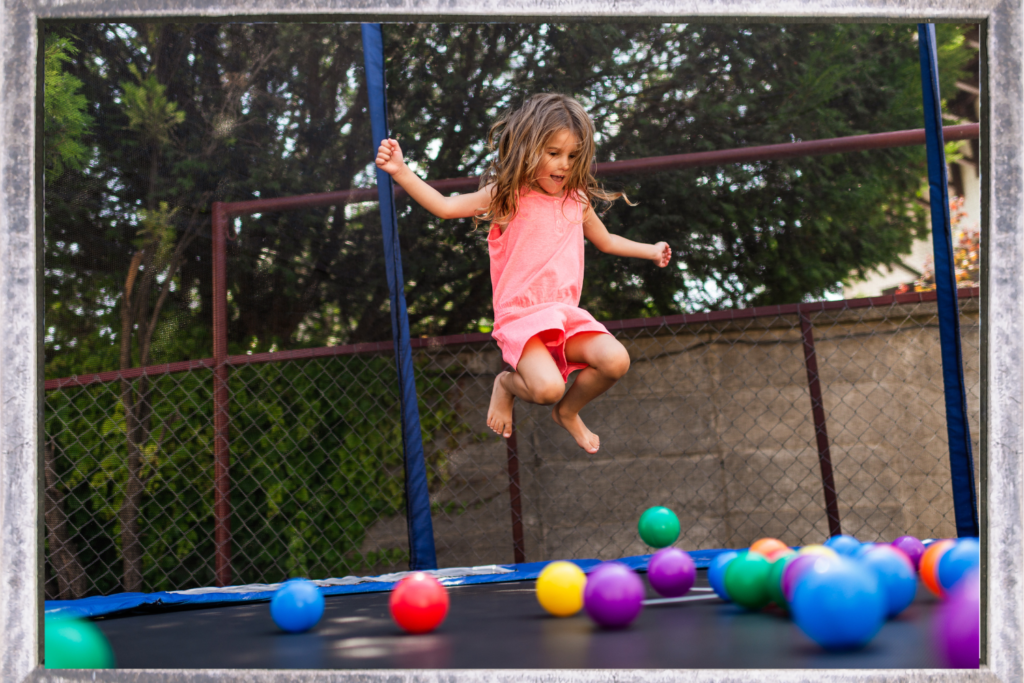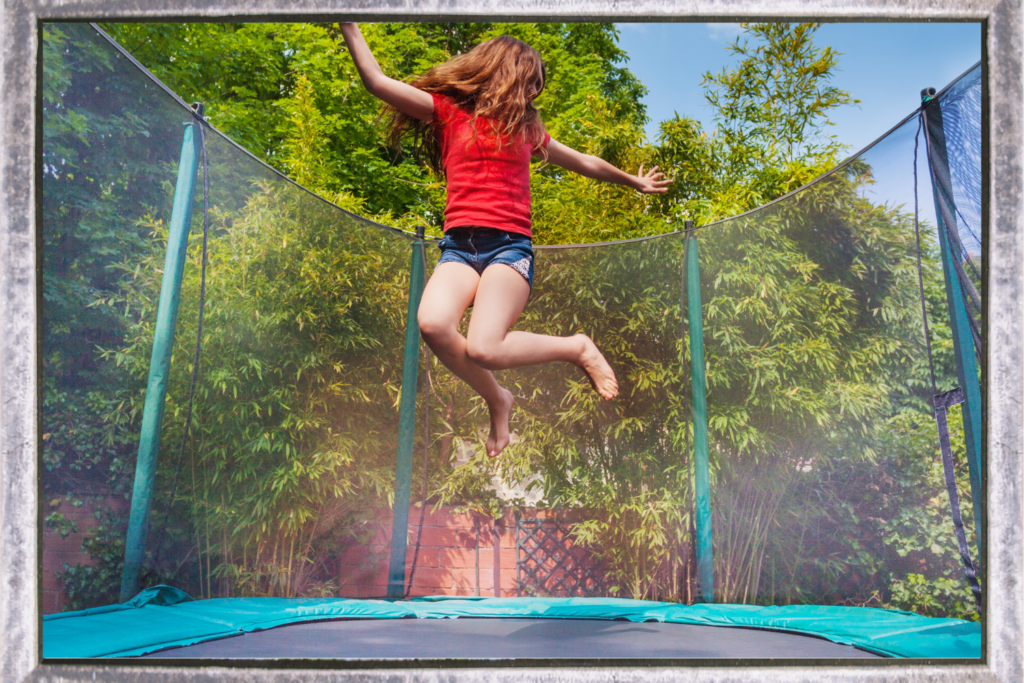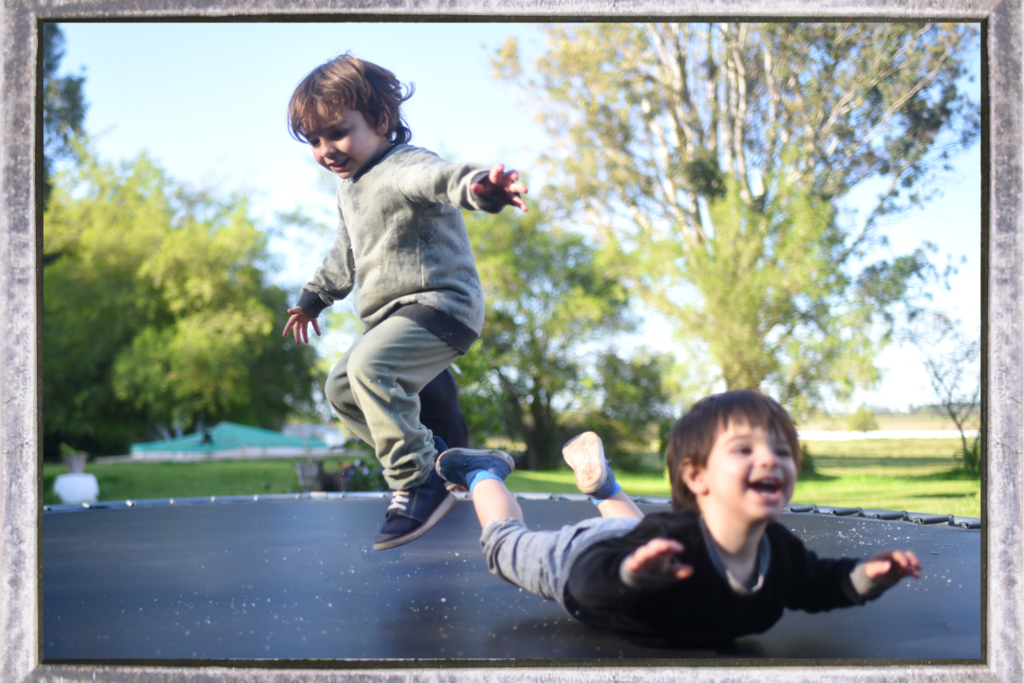
This post may contain affiliate links. As an Amazon affiliate, we earn from qualifying purchases. But we only recommend products we would use ourselves. View our disclosure policy here.
Trampolines provide endless fun and exercise for people of all ages. However, with great fun comes great responsibility. Ensuring the safety of trampoline users, proper setup, and regular maintenance are critical for a safe and enjoyable experience. This comprehensive guide delves into the top tips for trampoline safety, setup, and maintenance, incorporating expert advice to help you get the most out of your trampoline while minimizing risks. Whether you are a first-time trampoline owner or an experienced user looking to refresh your knowledge, this guide offers valuable insights and practical tips to create a secure and well-maintained trampoline environment for all. By following these guidelines, you can reduce the risk of injury and prolong the life of your trampoline, ensuring it remains a source of joy and fitness for years to come.

Trampoline Safety
Safety should be your foremost concern when it comes to trampolines. Here are some essential tips to ensure trampoline safety:
1. Supervision is Key
- Constant Supervision: Children should never be left unattended on a trampoline. Adult supervision is crucial to enforce safety rules and respond quickly in case of accidents. “Active supervision is essential. A responsible adult should always be present to oversee trampoline use,” advises Dr. Keith Alexander, a trampoline safety researcher. Supervision goes beyond just being physically present; it involves actively engaging with the children and ensuring they understand and follow the safety guidelines. Observing from a close distance allows adults to intervene immediately if risky behavior occurs, such as attempts at flips or stunts beyond their skill level. Moreover, supervisors can help mediate disputes that could lead to roughhousing or unsafe jumping. In addition to monitoring, adults should also model safe behavior and reinforce the importance of trampoline safety rules to the children consistently. This proactive approach not only reduces the risk of injuries but also instills lifelong habits of safety and responsibility in young trampoline users.
2. Safety Equipment
- Safety Nets and Pads: Invest in a high-quality safety net that encloses the entire trampoline. Safety pads covering the springs and frame are also essential to prevent injuries from hard surfaces. “Safety nets significantly reduce the risk of falling off the trampoline, which is one of the most common causes of injury,” notes Sarah Weaver, a trampoline safety expert. When selecting safety equipment, prioritize products that meet or exceed industry safety standards, such as those certified by ASTM International. Ensure that the safety net is securely fastened and does not have any gaps or weak points that could allow a child to slip through. Similarly, inspect the padding regularly to ensure it remains in good condition, fully covering all springs and the frame edges. Torn or worn-out pads should be replaced immediately. It’s also worth considering additional safety accessories like ladder guards to prevent small children from accessing the trampoline unsupervised. Proper installation and maintenance of safety equipment are critical; even the best products can’t provide protection if they aren’t used correctly or are in disrepair. Regularly checking and maintaining your safety equipment is a crucial part of creating a safe trampoline environment.
3. One at a Time Rule
- Limit the Number of Jumpers: Allow only one person to jump at a time. Collisions between jumpers can lead to serious injuries. “The majority of trampoline injuries occur when there are multiple jumpers, especially when there’s a significant weight difference,” states Dr. John Smith, an orthopedic surgeon. Enforcing the one-at-a-time rule helps to prevent accidents caused by unpredictable movements and uneven bounces. It also reduces the chances of smaller children being unintentionally bounced higher than they can control, which can lead to awkward landings and potential injuries. While children might find it more fun to jump together, it’s important to communicate the risks and ensure they understand that taking turns is essential for their safety. Consider organizing structured turn-taking games to make the experience enjoyable while maintaining safety.
Advice from Dr. John Smith: “The majority of trampoline injuries occur when there are multiple jumpers, especially when there’s a significant weight difference.”
4. Age-Appropriate Usage
- Age and Weight Limits: Follow the manufacturer’s guidelines regarding age and weight limits. Young children are more susceptible to injuries due to their lighter weight and developing motor skills. “Trampolines are not suitable for very young children, typically under six years old,” emphasizes Laura Mitchell, a pediatric safety consultant. For younger users, consider using smaller, age-appropriate trampolines with appropriate safety features. Always adhere to weight limits to prevent structural damage to the trampoline and ensure that older children do not inadvertently injure younger ones. Educate all users about the importance of following these guidelines and supervise closely to enforce them. Additionally, ensure that children understand the reasons behind these restrictions, helping them appreciate the importance of safety over fun.
Advice from Dr. Laura Mitchell: “Trampolines are not suitable for very young children, typically under six years old.”
5. Proper Jumping Techniques
- Teach Safe Jumping Practices: Encourage proper jumping techniques, such as landing with knees slightly bent and avoiding somersaults or flips without proper training. “Injuries often occur due to improper landing techniques. Educate users on safe practices to minimize risks,” advises Dr. Alexander. Providing clear instructions and demonstrating correct techniques can significantly reduce the risk of injuries. Emphasize the importance of maintaining balance and control, and discourage high-risk maneuvers that could lead to falls or awkward landings. Consider enrolling children in a trampoline class or gymnastic program to learn advanced techniques safely under professional supervision. Regularly remind and reinforce these practices to ensure they become second nature to all trampoline users.
6. Inspect Before Use
- Pre-Use Inspection: Before each use, check the trampoline for any damage or wear and tear. Ensure that the frame, springs, and mat are in good condition. “Regular inspections can prevent accidents caused by faulty equipment,” says Sarah Weaver. Look for signs of rust, fraying, or tears, and ensure that all safety nets and pads are securely in place. Springs should be intact and tightly attached, with no gaps or loose ends. If any issues are found, address them immediately before allowing anyone to use the trampoline. Keeping a checklist for these inspections can help ensure nothing is overlooked. Regular maintenance not only enhances safety but also prolongs the life of the trampoline.
7. Clear Surrounding Area
- Safe Placement: Ensure the trampoline is placed on a flat, level surface away from hazards such as trees, fences, and hard surfaces. A minimum clearance of 8 feet around the trampoline is recommended. “A safe environment around the trampoline can prevent many injuries,” highlights Dr. Smith. The ground should be soft and impact-absorbing, like grass or specially designed rubber mulch, to cushion any falls. Avoid placing the trampoline on concrete, asphalt, or other hard surfaces. Additionally, keep the area free of toys, garden tools, and other objects that could cause tripping or falls. Establishing a designated trampoline zone helps in maintaining a safe and controlled environment for all users.
8. Enforce Safety Rules
- Establish and Enforce Rules: Set clear safety rules, such as no roughhousing, no jumping off the trampoline, and no use when wet or windy. “Clear, enforced rules are critical for maintaining a safe trampoline environment,” states Laura Mitchell. Write down the rules and post them near the trampoline for easy reference. Consistently enforce these rules to ensure that all users understand and follow them. Educate children on the reasons behind each rule to help them appreciate their importance. Regularly review and update the rules as needed, especially if new risks or behaviors emerge. Creating a culture of safety around the trampoline not only prevents injuries but also ensures that everyone can enjoy the trampoline responsibly and confidently.
Trampoline Setup
Setting up your trampoline correctly is crucial for both safety and performance. Here are the key steps to follow:
1. Choose the Right Location
- Flat, Level Ground: Select a flat, level area free of obstacles and overhanging branches. Ensure the ground is firm and stable to support the trampoline’s weight. If the ground is uneven or slopes, the trampoline may become unstable, leading to potential tipping or uneven bounces, which can cause injuries. Avoid areas prone to water pooling, as moisture can lead to rust and damage over time. Additionally, consider the surrounding environment; avoid placing the trampoline near garden beds or trees that could drop leaves and debris onto the jumping surface.
- Safe Clearance: Allow for at least 8 feet of clearance around the trampoline and a height clearance of 20 feet above. This ensures jumpers do not hit surrounding objects or overhanging branches. Maintaining this clearance helps prevent accidental impacts with nearby structures, such as fences or walls, and reduces the risk of injury from hitting obstacles during a jump.
2. Assemble with Care
- Follow Instructions: Carefully follow the manufacturer’s assembly instructions. This includes securing the frame, attaching the springs, and ensuring the mat is taut and evenly stretched. Taking the time to read and understand the manual can prevent common setup mistakes that could compromise safety. Assemble the trampoline in a step-by-step manner, double-checking each stage to ensure everything is correctly installed.
- Use Proper Tools: Utilize the tools provided or recommended by the manufacturer to avoid damaging parts during assembly. Using inappropriate tools can lead to improper assembly and potentially weaken the structure. If tools are not provided, ensure you have the right equipment on hand before beginning assembly. Having a second person to help can make the process smoother and safer, especially when dealing with larger parts like the frame and jumping mat.
3. Install Safety Features
- Safety Nets: Attach the safety net securely to the frame, ensuring it fully encloses the jumping area without gaps. The net should be attached at multiple points along the frame to prevent it from coming loose during use. Ensure the entry point is equipped with a secure zipper or latch to prevent accidental openings.
- Safety Pads: Place pads over the springs and frame to cushion any impact and prevent injuries. These pads should cover all metal parts, including the hooks and springs, to minimize the risk of pinching or impact injuries. Regularly check that the pads are securely fastened and in good condition, as loose or damaged pads can compromise safety.

Playing on a trampoline provides kids with excellent exercise, enhancing cardiovascular health, coordination, and muscle strength. It offers a fun, engaging way to stay active, encouraging physical fitness while improving balance and agility, making exercise an enjoyable part of their daily routine.
4. Secure the Trampoline
- Anchor Kits: Use anchor kits or wind stakes to secure the trampoline to the ground, especially in windy areas. This prevents the trampoline from tipping over or being blown away. Anchor kits typically include stakes that are driven into the ground and straps that connect to the trampoline frame. This is particularly important if you live in an area prone to high winds or storms, as an unsecured trampoline can become a dangerous projectile.
- Additional Stability Measures: In regions with extreme weather, consider adding sandbags or additional weights to the frame for extra stability. Regularly check the anchors to ensure they remain secure and adjust them if the ground shifts or becomes loose.
5. Regular Checkups
- Post-Assembly Checks: After assembling, double-check all connections and fittings. Periodically re-tighten bolts and screws to maintain stability. Even with a secure initial setup, vibrations and use can cause parts to loosen over time. A regular checkup schedule helps catch and correct these issues before they lead to bigger problems.
- Routine Inspections: Schedule routine inspections, particularly after periods of heavy use or severe weather. Look for signs of wear and tear, rust, or damage to the frame, springs, and mat. Address any issues immediately to maintain a safe jumping environment. Keeping a maintenance log can help track inspections and repairs, ensuring nothing is overlooked.

Trampoline Maintenance
Proper maintenance ensures the longevity and safety of your trampoline. Here are essential maintenance tips:
1. Regular Inspections
- Weekly Checks: Inspect the trampoline weekly for any signs of wear and tear, including the frame, springs, mat, and safety net. Look for rust, frayed stitching, and tears. Springs should be tightly attached and free of corrosion. Regular checks help catch potential issues early, preventing them from becoming serious hazards. “Routine inspections are essential to ensure your trampoline remains safe and functional,” advises Sarah Weaver, a trampoline safety expert.
- Seasonal Inspections: Conduct thorough inspections at the start and end of each season, looking for rust, frayed stitching, and other potential hazards. During these inspections, pay special attention to parts that might have been affected by changes in weather, such as extreme temperatures or humidity. This is also a good time to apply any necessary treatments, like anti-rust spray, to metal components.
2. Cleanliness
- Keep It Clean: Regularly clean the mat and frame to remove dirt, leaves, and debris. Use mild soap and water, avoiding harsh chemicals that can damage the materials. Cleaning helps maintain the appearance of the trampoline and prevents the buildup of dirt and grime that can cause wear and tear. “A clean trampoline is a safe trampoline,” notes Dr. John Smith, an orthopedic surgeon.
- Remove Debris: Ensure no debris is trapped between the springs and mat, which could cause damage or unsafe jumping conditions. This includes checking underneath the trampoline where leaves and other debris can accumulate. Keeping the area around the trampoline clear also helps prevent dirt and debris from being tracked onto the jumping surface.
3. Weather Protection
- Cover It Up: Use a weather cover when the trampoline is not in use to protect it from sun, rain, and snow. UV rays can degrade the mat and safety net, while moisture can lead to rust on the springs and frame. A good quality cover can extend the life of your trampoline by shielding it from the elements. Make sure the cover fits well and is securely fastened to prevent it from blowing away in strong winds.
- Seasonal Storage: In areas with harsh winters, consider disassembling the trampoline and storing it indoors to prevent damage from ice and snow. If disassembly is not practical, ensure the trampoline is well-anchored and covered to withstand winter conditions. Regularly remove snow buildup to prevent excess weight from damaging the mat and springs.
4. Component Replacement
- Replace Worn Parts: Promptly replace any damaged or worn parts, such as springs, pads, or the jumping mat. Using damaged components increases the risk of injury. Keep spare parts on hand to ensure quick replacements when needed. “Using manufacturer-approved parts is crucial for maintaining safety and performance,” says Laura Mitchell, a pediatric safety consultant.
- Quality Parts: Always use manufacturer-approved replacement parts to ensure compatibility and safety. Generic or off-brand parts may not meet the same safety standards and could lead to equipment failure. When ordering replacement parts, verify the model and specifications of your trampoline to ensure a proper fit.
5. Lubrication
- Springs and Joints: Periodically lubricate the springs and joints to prevent rust and ensure smooth operation. Use a silicone-based lubricant that won’t damage the metal or the jumping mat. Lubricating these parts can reduce noise and friction, making for a smoother, more enjoyable jumping experience. Apply lubricant sparingly and wipe off any excess to prevent it from attracting dirt and debris.
- Frequency: The frequency of lubrication will depend on how often the trampoline is used and the environmental conditions. In humid or rainy climates, you may need to lubricate more frequently to prevent rust. Regularly inspect the springs and joints during your weekly checks to determine if lubrication is needed.
Maintaining a trampoline requires diligence, but the payoff in safety and extended lifespan is well worth the effort. By following the guidelines for setup, safety, and maintenance, you can create a secure environment for trampoline users of all ages. Remember, consistent supervision, proper use of safety equipment, and routine inspections are the cornerstones of trampoline safety. As Dr. Keith Alexander wisely puts it, “A well-maintained trampoline is not just a source of fun, but also a commitment to safety.” Investing time in proper setup and regular maintenance not only protects your loved ones but also ensures that your trampoline remains a cherished part of your backyard for many years. Stay proactive and informed, and your trampoline will continue to provide countless hours of enjoyment and exercise.
Other articles you may find interesting. We hope you enjoy our tips, tricks, and ideas.
